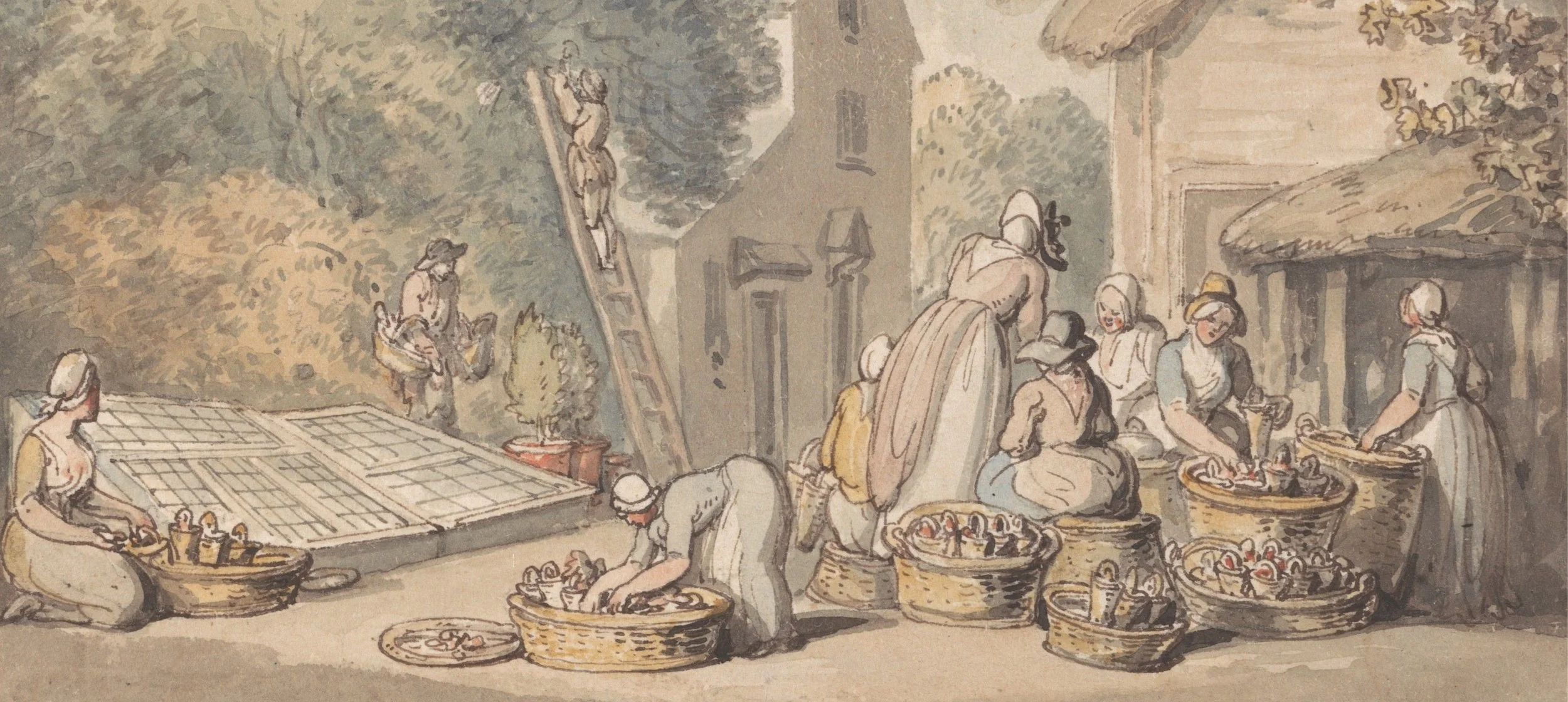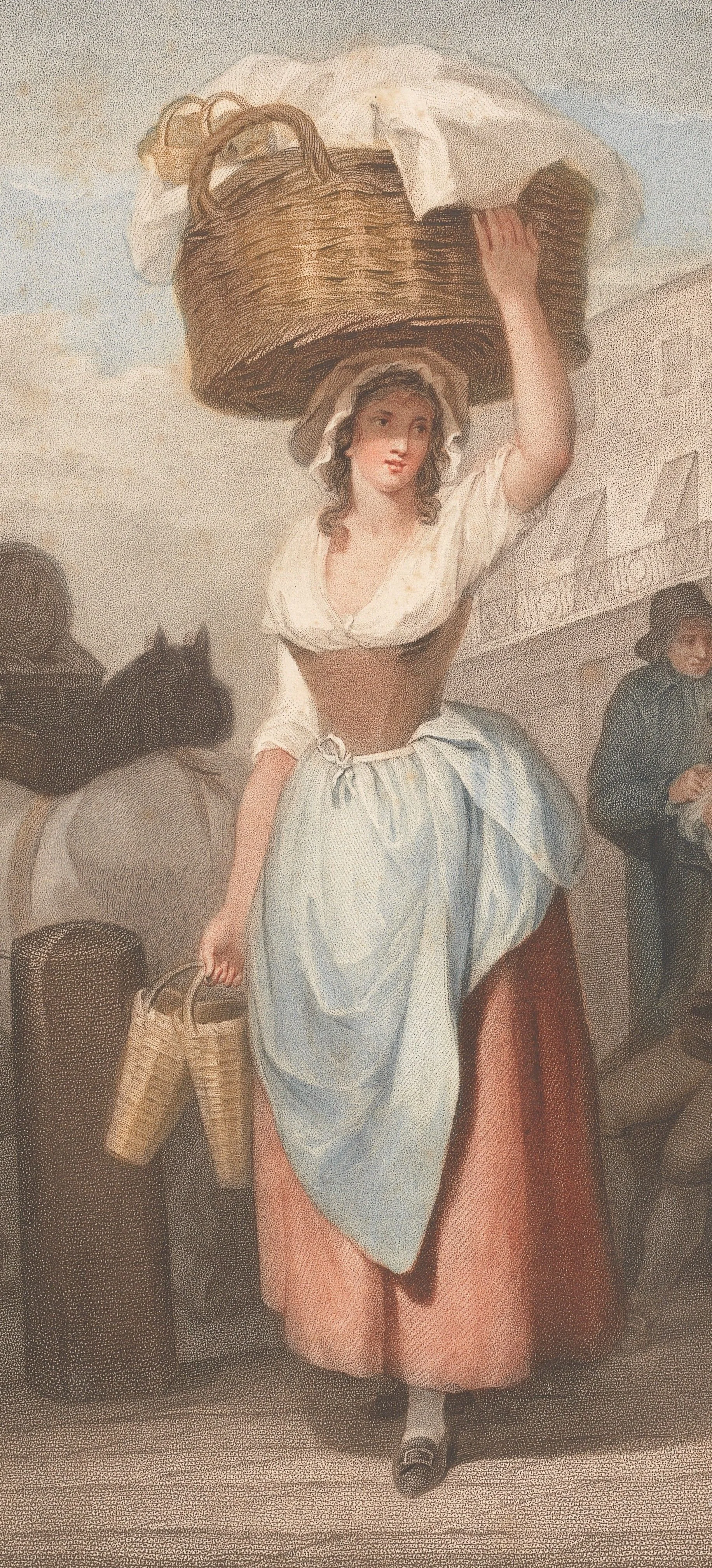A pottle, technically speaking, is a unit of volume equal to 2 quarts or ½ gallon (see The London Adviser and Guide, for example).
The word “pottle” is also used to describe a sort of conical basket used to carry produce – often strawberries or other small fruits – as they are sold in markets or by street vendors. The Universal Gardener and Botanist (1778) provides a description:
Pottle baſkets are the moſt convenient for ſending quantities of ſtrawberries, raſpberries, and mulberries, choicer ſorts of early cherries, and the moſt delicate ſorts of ſmall plums, to market, or to any diſtance; theſe are very ſmall, upright, chip Baſkets, holding about a quart, being ten or twelve inches deep, very narrow at bottom, and not more than four or five inches wide at top, where there is a croſs handle. The London gardeners uſe vaſt quantities of them, buy them at ninepence or a ſhilling per dozen, which when filled with fruit, they pack many together in a large Boat-baſket, ſo ſend them to market on men’s heads, or otherwiſe.
The London Museum describes their use in the early 19th century:
Strawberries were cried by both men and women in June in London suburbs. They were sold for sixpence in pottles that held less than a quart. The crier added one penny to the selling price for the value of the pottle that was refunded if the customer returned it. The criers’ profit was between threepence and fourpence in the shilling.
Additional Resources
Strawberries in Pottles and Punnets
28th June 1777. Strawberries minus the Cream. (On July 3, 1782, “a cold repast, a pottle of strawberries.”)
History of strawberry packages …
When [ſtrawberries] are to be ſent to market (1778)
The mode by which London is supplied with strawberries (1834)
How London is supplied with strawberries (1861)
A history of the cries of London, ancient and modern (1881)
Around the Mahogany suggests that pottles were unknown in America in 1871 but still in use in England; strawberry vendors in New York in 1808 and 1825 used shorter round baskets
Fruit-pickers pack fresh berries in pottles, and then place the pottles in larger boat-baskets to be taken to market.
A hawker carries the boat-basket to sell pottles of berries to customers.
© The Trustees of the British Museum. Shared under a Creative Commons Attribution-NonCommercial-ShareAlike 4.0 International (CC BY-NC-SA 4.0) licence.
The Cryes of the City of London Drawne after the Life: Ripe Strawberries (1688, reworked after c. 1750)
Draft trade card of Eleanor Ogle, fruiterer, c. 1760
A lady in full dress, seen from behind by Samuel Scott
A young woman in rustic dress, c. 1760-1783
A naive woolwork of a basket of strawberries worked by Lady Elizabeth Archer, a sister to the Earl of Halifax, late 18th century
Betty (portrait of Betty Munro, a fruit seller), c. 1766-1783
A boy steals fruit from pottles stored in a larger basket on the right side of The Female Orators, 1768
A lady in full dress, seen from behind by Samuel Scott
Scene in a London Street by John Collet, 1770
Kitchen Scene by John Atkinson, 1771
Girl Bundling Asparagus by John Atkinson, 1771
The Strawberry Girl by Joshua Reynolds, 1772-1773
The Strawberry Girl by Joshua Reynolds, 1773-1777
The Strawberry Girl (Sarah Margaret Edwards), 1770s; also here
Draft trade card of James Cook, fruiterer, c. 1775
Fruit Stall, 1777
Draft trade card of Edward Owen, fruiterer, c. 1785
A View of the Parade at Bath, c. 1785
The Cries of London: Strawberrys, Scarlet Strawberrys, 1795
Paddy O’Blarney, 1796
Hero’s recruiting at Kelsey’s; or Guard-Day at St James’s, 1797
Picking Mulberries by Thomas Rowlandson
Draft trade card of Smith, fruiterer, c. 1800
Scarlet Strawberries in The New Cries of London, 1803
Strawberries, Covent Garden, 1804
Portrait of a young girl, said to be a Stanley of the Derby family, by John Hoppner, c. 1805 (H/T Paul Dickfoss)
Folkstone Strawberries or More Carraway Comfits for Mary Ann, 1810
London Markets: Fruit, 1822
A basket of strawberries, 19th century


